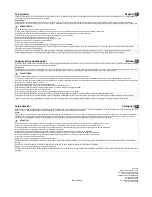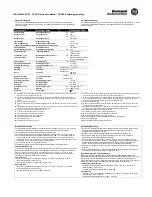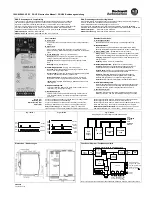
1606-XLS240-UPSC DC-UPS Instruction Manual / DC-USV Bedienungsanleitung
General Description
The 1606-XLS240-UPSC offers DIN-rail DC-UPS which bridge power outages for minutes by
utilizing only one 12V battery for a 24V output. The 1606-XLS240-UPSC has one integrated 5Ah
high-current battery.
Gerätebeschreibung:
Das 1606-XLS240-UPSC dient zur Überbrückung von Netzausfällen im Minutenbereich, hierfür
wird nur eine 12V Batterie benötigt. Das 1606-XLS240-UPSC hat eine integrierte 5Ah
Hochstrombatterie.
Technical Data
1)
Technische Daten
1)
1606-XLS240-UPSC
Output Voltage
Ausgangsspannung
nom.
22.25V
2)
Output Current
Ausgangsstrom
nom.
15A
3)
nom.
10/ 15A
4)
Output Power
Ausgangsleistung
240/ 360W
5)
Input Voltage
Eingangsspannung
DC 24V
Input Voltage Range
Eingangsspannungsbereich
22.5 – 30Vdc
Transfer Threshold Buffer Mode Umschaltschwelle Pufferbetrieb
22.25V
Allowed Batteries
Erlaubte Batterien
12V, VRLA
Allowed Battery Capacity
Erlaubte Batteriekapazität
nom.
5Ah
Integrated Battery
Integrierte Batterie
5Ah high-current /
Hochstromtyp
Dimensions
(wxhxd)
Batterie
Abmessungen
(BxHxT)
nom
90x106x70mm
6)
Type of Terminals
Anschlüsse
Blade-type 250/ Flachstecker
für 6.35mm Steckhülse
Power Losses
Verlustleistung
typ.
2.9/5.5W
7)
Operational Temperature
Betriebstemperatur
0 - +40°C
Storage Temp. Range
Lagertemperaturbereich
-20 - +50°C
Humidity Feuchte
IEC60068-2-30
5 - 95% r.H.
8)
Vibration Schwingen
IEC 60068-2-6
1g
9)
Shock Schocken
IEC60068-2-27
15g 6ms,
10g 11ms
9)
Degree of Pollution
Verschmutzungsgrad
EN 50078
2
Degree of Protection
Schutzart
EN 60529
IP20
Over-temp. Protection
Übertemperaturschutz
Yes / Ja
10)
Parallel Use
Parallelschaltbar
No / Nein
Serial Use
Serienschaltbar
No / Nein
Dimensions
(wxhxd)
Abmessungen
(BxHxT)
nom.
123x124x119mm
11)
Weight Gewicht
max.
2850g / 6.28lb
Approvals Zulassungen
12)
1)
All parameters are specified at 24Vdc input voltage, nominal output current, 25°C ambient and after a 5
minutes run-in time unless otherwise noted.
2)
The output voltage is regulated to 22.25Vdc in a buffer event. In all other cases, the output voltage is
approx. 0.3V lower than the input voltage assuming that the input voltage is sufficient and no overload is
present.
3)
When no buffer event is present.
4)
During a buffer event 15A is available for the first 5 seconds. After this time, the output current is limited to
10A.
5)
The allowed output power is 360W when no buffer event is present as well as for the first 5 seconds during
a buffer event. After this, the allowed output power is 240W.
6)
Battery container height without terminals: 102mm
7)
At no load / 10A load, no buffer event is present.
8)
Do not energize while condensation is present.
9)
Use wall mounting accessory for higher values.
10)
Output shuts down with automatic restart.
11)
Depth without DIN-rail.
12)
See datasheet or markings on the unit.
1)
Alle Werte gelten bei 24Vdc Eingangsspannung, Nennausgangsstrom, 25°C Umgebung und nach
einer Aufwärmzeit von 5 Minuten, wenn nichts anderes angegeben ist.
2)
Während eines Pufferfalls ist die Ausgangsspannung auf 22.25V geregelt. In allen anderen Fällen ist
die Ausgangsspannung etwa 0,3V kleiner als die Eingangsspannung vorausgesetzt, dass die
Eingangsspannung im spez. Bereich ist und kein Überlastfall vorliegt.
3)
Wenn kein Pufferfall vorliegt.
4)
Während eines Pufferfalls stehen für die ersten 5 Sekunden 15A zur Verfügung. Danach ist der
Ausgangsstrom auf 10A begrenzt.
5)
Die erlaubte Ausgangsleistung ist 360W wenn kein Pufferfall besteht oder während der ersten 5
Sekunden eines Pufferfalls. Danach ist die erlaubte Ausgangsleistung 240W.
6)
Batterie-Gehäuse Höhe ohne Anschlüsse: 102mm
7)
Bei Leerlauf / 10A Last und wenn kein Pufferfall besteht.
8)
Nicht betreiben, solange das Gerät Kondensation aufweist.
9)
Mit Wandmontage-Zubehör höhere Werte erreichbar.
10)
Ausgang schaltet ab und macht regelmäßig automatische Startversuche.
11)
Tiefe ohne DIN-Schiene.
12)
Siehe Datenblatt oder Prüfzeichen auf dem Gerät.
Installation Procedure
1. Use DIN-rails according to EN 60715 or EN 50022 with a height of 15mm. The unit is convection
cooled. Do not obstruct air flow! Ventilation grid must be kept free of any obstructions.
2. Connect the power supply to the input terminals of the DC-UPS.
3. Disconnect the fuse on the front of the DC-UPS before working on the unit or on the battery.
4. Connect the buffered load to the output terminals of the DC-UPS. The output is decoupled from
the input allowing load circuits to be easily split into buffered and non buffered sections. Non-
critical loads can be connected directly to the power supply and will not be buffered. The energy in
the battery will be used in the circuits which require buffering.
5. Set the buffer time limiter to an appropriate value.
6. Install the fuse when the wiring is finished. Red LED on the DC-UPS should turn off.
Terminals and Wiring
The units are equipped with spring-clamp terminals for the power port and with a plug connector for
the signal port. Use appropriate copper cables that are designed for an operating temperatures of
60°C (for ambient up to 45°C) and 75°C (for ambient up to 60°C), minimum. Follow national
installation codes and regulations! Ensure that all strands of a stranded wire enter the terminal
connection! Ferrules are allowed, but not required.
Power terminals:
Solid wire / Stranded wire / American wire gauge: 0.5-6mm
2
/ 0.5-4mm
2
/ 20-10 AWG
Wire stripping length: 10mm / 0.4inch
Pull-out force (UL 486E): 10AWG: 80N, 12AWG: 60N
Signal terminals:
Solid wire / Stranded wire / American wire gauge: 0.2-1.5mm
2
/ 0.2-1.5mm
2
/ 22-14 AWG
Wire stripping length: 6mm / 0.25inch
Recommended tightening torque: 0.4Nm / 3.5lb.inch
Installationsanleitung:
1. Geeignet zur Montage an DIN-Schienen entsprechend EN 60715 oder EN 50022 mit einer
Höhe von 15mm. Das Gerät ist für Konvektionskühlung ausgelegt. Es ist für eine
ungehinderte Luftzirkulation zu sorgen.
2. Schließen Sie die Stromversorgung and die “Input” Klemmen der DC-USV an.
3. Ziehen Sie die Sicherung an der Front des Gerätes heraus, bevor Sie die Batterie
anschließen oder Installationsarbeiten durchführen.
4. Schließen Sie die zu puffernde Last an die „Output“ Klemmen an. Der Ausgang ist vom
Eingang entkoppelt. So kann man Lasten in gepufferte und ungepufferte Zweige aufteilen.
Unkritische Lasten können ungepuffert direkt an die Stromversorgung angeschlossen
werden. So wird die Energie der Batterie nur für zu puffernde Lasten verwendet.
5. Stellen Sie am "Buffer-Time-Limiter" Einsteller (Pufferzeit-Begrenzer) den entsprechenden
Wert ein.
6. Stecken Sie die Sicherung ein, wenn alle Arbeiten an der Batterie oder DC-USV beendet
sind. Nach dem Einschalten muss die rote LED erlöschen.
Anschlussklemmen und Verdrahtung
Die Geräte sind mit Schnellanschluss-Federkraftklemmen ausgestattet. Verwenden Sie
geeignete Kupferkabel, die mindestens für 60°C (bei einer Umgebungstemperatur bis zu 45°C)
und 75°C (bei einer Umgebungstemperatur bis zu 60°C) zugelassen sind. Beachten Sie
nationale Bestimmungen und Installationsvorschriften! Stellen Sie sicher, dass keine einzelnen
Drähte von Litzen abstehen. Aderendhülsen sind erlaubt, aber nicht erforderlich.
Leistungsanschlussklemmen:
Starrdraht / Litze / Amerikanischer Querschnitt: 0,5-6mm
2
/ 0,5-4mm
2
/ 20-10 AWG
Abisolierlänge: 10mm / 0,4inch
Abziehkraft (UL 486E): 10AWG: 80N, 12AWG: 60N
Signalklemmen:
Starrdraht / Litze / Amerikanischer Querschnitt: 0,2-1,5mm
2
/ 0,2-1,5mm
2
/ 22-14 AWG
Abisolierlänge: 6mm / 0,25inch
Empfohlenes Anzugsdrehmoment: 0,4Nm / 3.5lb.inch






















